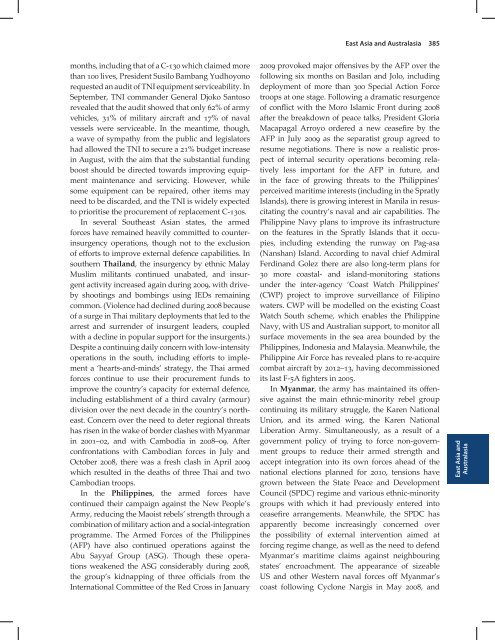You also want an ePaper? Increase the reach of your titles
YUMPU automatically turns print PDFs into web optimized ePapers that Google loves.
months, including that of a C-��� which claimed more<br />
than ��� lives, President Susilo Bambang Yudhoyono<br />
requested an audit of TNI equipment serviceability. In<br />
September, TNI commander General Djoko Santoso<br />
revealed that the audit showed that only ��% of army<br />
vehicles, ��% of military aircraft and ��% of naval<br />
vessels were serviceable. In the meantime, though,<br />
a wave of sympathy from the public and legislators<br />
had allowed the TNI to secure a ��% budget increase<br />
in August, with the aim that the substantial funding<br />
boost should be directed towards improving equipment<br />
maintenance and servicing. However, while<br />
some equipment can be repaired, other items may<br />
need to be discarded, and the TNI is widely expected<br />
to prioritise the procurement of replacement C-���s.<br />
In several Southeast Asian states, the armed<br />
forces have remained heavily commi�ed to counter-<br />
insurgency operations, though not to the exclusion<br />
of efforts to improve external defence capabilities. In<br />
southern Thailand, the insurgency by ethnic Malay<br />
Muslim militants continued unabated, and insurgent<br />
activity increased again during ����, with driveby<br />
shootings and bombings using IEDs remaining<br />
common. (Violence had declined during ���� because<br />
of a surge in Thai military deployments that led to the<br />
arrest and surrender of insurgent leaders, coupled<br />
with a decline in popular support for the insurgents.)<br />
Despite a continuing daily concern with low-intensity<br />
operations in the south, including efforts to implement<br />
a ‘hearts-and-minds’ strategy, the Thai armed<br />
forces continue to use their procurement funds to<br />
improve the country’s capacity for external defence,<br />
including establishment of a third cavalry (armour)<br />
division over the next decade in the country’s northeast.<br />
Concern over the need to deter regional threats<br />
has risen in the wake of border clashes with Myanmar<br />
in ����–��, and with Cambodia in ����–��. After<br />
confrontations with Cambodian forces in July and<br />
October ����, there was a fresh clash in April ����<br />
which resulted in the deaths of three Thai and two<br />
Cambodian troops.<br />
In the Philippines, the armed forces have<br />
continued their campaign against the New People’s<br />
Army, reducing the Maoist rebels’ strength through a<br />
combination of military action and a social-integration<br />
programme. The Armed Forces of the Philippines<br />
(AFP) have also continued operations against the<br />
Abu Sayyaf Group (ASG). Though these operations<br />
weakened the ASG considerably during ����,<br />
the group’s kidnapping of three officials from the<br />
International Commi�ee of the Red Cross in January<br />
East Asia and Australasia<br />
385<br />
���� provoked major offensives by the AFP over the<br />
following six months on Basilan and Jolo, including<br />
deployment of more than ��� Special Action Force<br />
troops at one stage. Following a dramatic resurgence<br />
of conflict with the Moro Islamic Front during ����<br />
after the breakdown of peace talks, President Gloria<br />
Macapagal Arroyo ordered a new ceasefire by the<br />
AFP in July ���� as the separatist group agreed to<br />
resume negotiations. There is now a realistic prospect<br />
of internal security operations becoming relatively<br />
less important for the AFP in future, and<br />
in the face of growing threats to the Philippines’<br />
perceived maritime interests (including in the Spratly<br />
Islands), there is growing interest in Manila in resuscitating<br />
the country’s naval and air capabilities. The<br />
Philippine Navy plans to improve its infrastructure<br />
on the features in the Spratly Islands that it occupies,<br />
including extending the runway on Pag-asa<br />
(Nanshan) Island. According to naval chief Admiral<br />
Ferdinand Golez there are also long-term plans for<br />
�� more coastal- and island-monitoring stations<br />
under the inter-agency ‘Coast Watch Philippines’<br />
(CWP) project to improve surveillance of Filipino<br />
waters. CWP will be modelled on the existing Coast<br />
Watch South scheme, which enables the Philippine<br />
Navy, with US and Australian support, to monitor all<br />
surface movements in the sea area bounded by the<br />
Philippines, Indonesia and Malaysia. Meanwhile, the<br />
Philippine Air Force has revealed plans to re-acquire<br />
combat aircraft by ����–��, having decommissioned<br />
its last F-�A fighters in ����.<br />
In Myanmar, the army has maintained its offensive<br />
against the main ethnic-minority rebel group<br />
continuing its military struggle, the Karen National<br />
Union, and its armed wing, the Karen National<br />
Liberation Army. Simultaneously, as a result of a<br />
government policy of trying to force non-government<br />
groups to reduce their armed strength and<br />
accept integration into its own forces ahead of the<br />
national elections planned for ����, tensions have<br />
grown between the State Peace and Development<br />
Council (SPDC) regime and various ethnic-minority<br />
groups with which it had previously entered into<br />
ceasefire arrangements. Meanwhile, the SPDC has<br />
apparently become increasingly concerned over<br />
the possibility of external intervention aimed at<br />
forcing regime change, as well as the need to defend<br />
Myanmar’s maritime claims against neighbouring<br />
states’ encroachment. The appearance of sizeable<br />
US and other Western naval forces off Myanmar’s<br />
coast following Cyclone Nargis in May ����, and<br />
East Asia and<br />
Australasia


